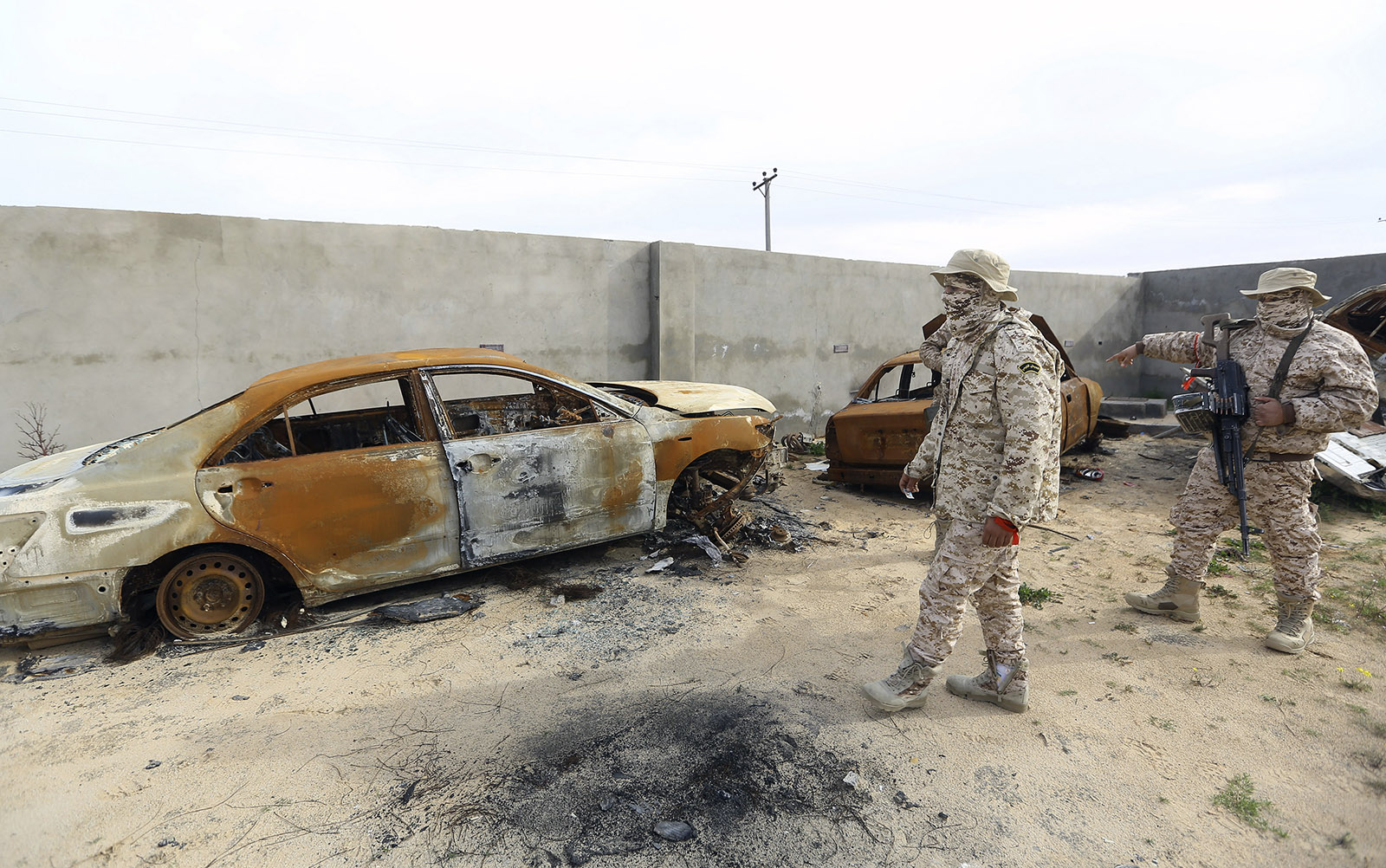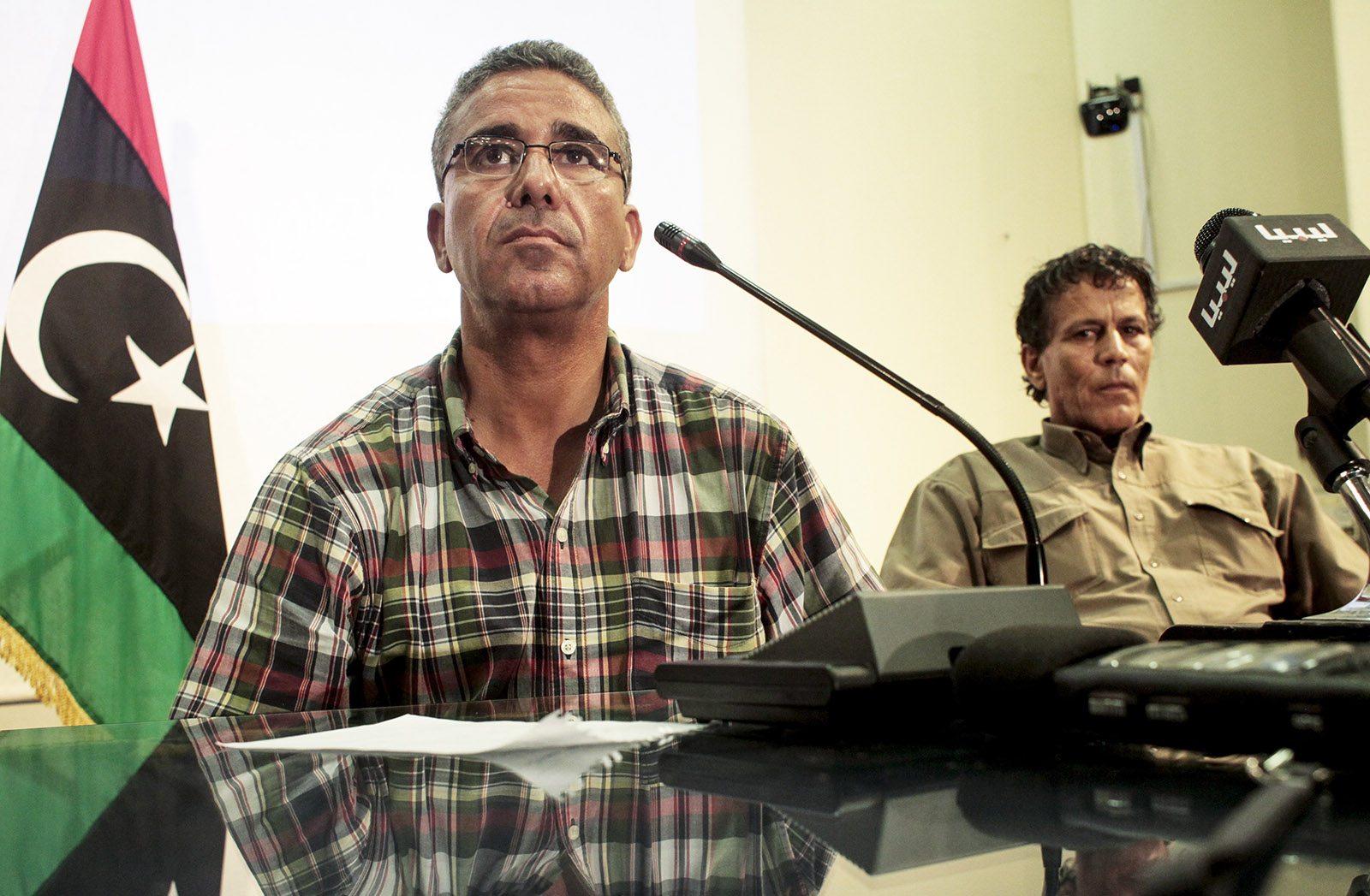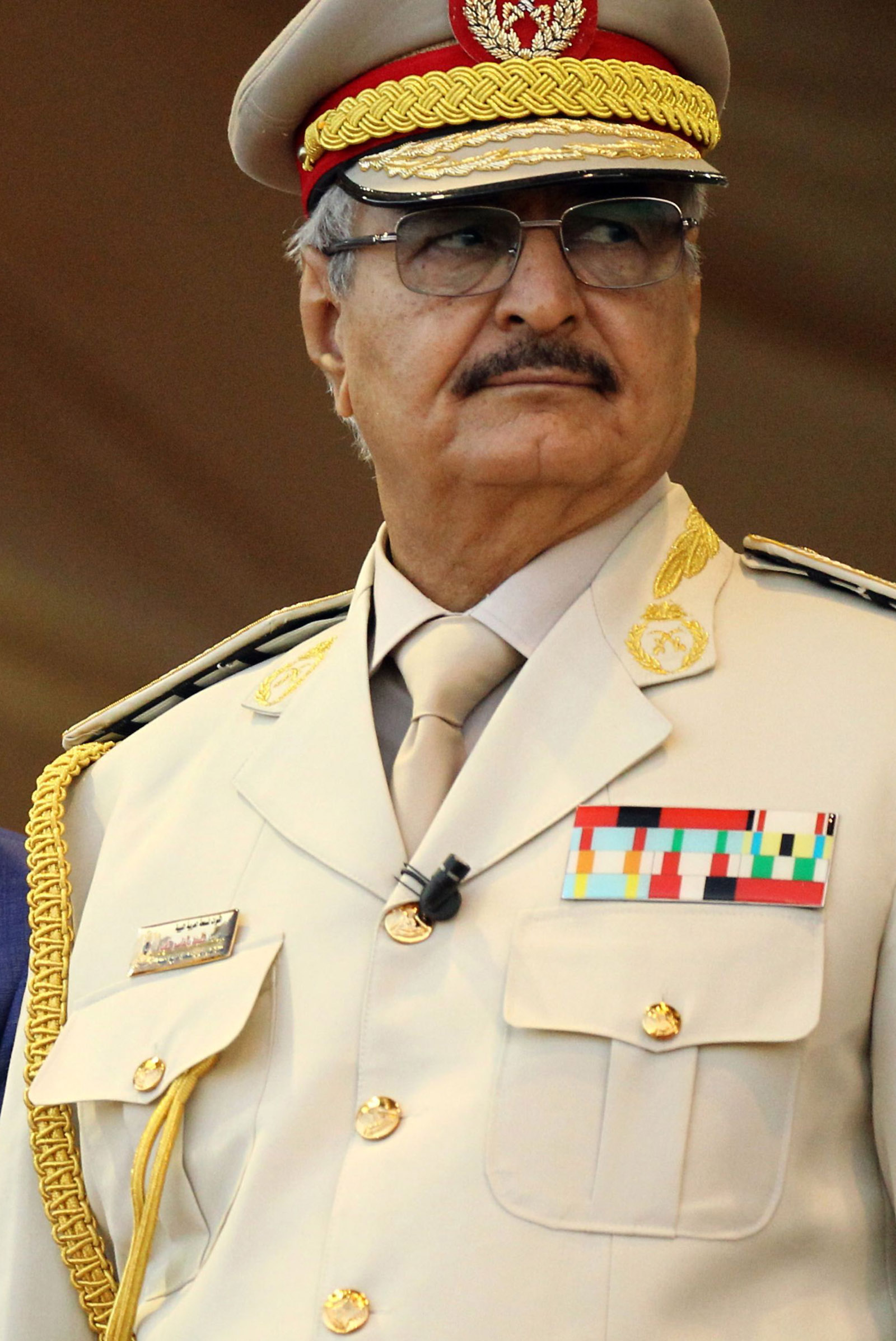Sabratha, Libya—A sleepy town of smalltime farmers and traders, Sabratha sits on the Mediterranean seaboard just west of the capital Tripoli. It is most famous for its Roman ruins—a colonnaded city and a restored amphitheater that, under the late ruler Muammar Qaddafi, hosted floodlit performances of Puccini’s operas for busloads of Italian tourists. The tourists are gone now and the town has suffered a series of afflictions since the 2011 overthrow of the dictator. In early 2016, it became the site of a fierce battle against Islamic State jihadists, who had set up a training camp in nearby date palm groves. Emboldened by a US airstrike on that camp, local militias pushed out the terrorist group.
Then came a new bane: the reign of smugglers and human traffickers, and pitched battles to staunch this lucrative trade. The clashes killed scores and blotted the ancient amphitheater with the charred blossoms of rocket-propelled grenades and bullet holes. Still, when I visited the ruins one afternoon this February, normalcy had returned. Families picnicked on grassy patches between the pillars, where the winter rains had left a dusting of dandelions.
Another shadow now hangs over the town. Khalifa Haftar, the septuagenarian Libyan army general, was a dissident during the Qaddafi regime and onetime CIA asset. In May of 2014, he led a group of disaffected army units and local tribes in a military assault on Islamists and jihadists in the eastern city of Benghazi. After years of grinding combat, he won the east and turned his sights on the west.
In recent weeks, his coalition of forces, the Libyan National Army, has blitzed across Libya’s vast southern desert, seizing strategic oilfields and airbases. He is now encroaching on Tripoli, where the isolated, internationally backed Government of National Accord has failed in basic governance and is beholden to militia barons who have carved the capital into fiefdoms and plundered the state’s coffers. The result of Haftar’s offensive has been a major shift in the balance of power in Libya. “A reshuffling of the deck of cards,” a United Nations official in Tripoli told me.
Military and financial support from foreign patrons—the United Arab Emirates, Egypt, France, and Russia—has been essential to his drive. For its part, the United States has long eyed him warily and has officially backed the Tripoli government, even while maintaining an intelligence and special operations presence among his forces in Benghazi. Increasingly, however, US diplomats see Haftar as crucial to moving Libya beyond a drawn-out “transition” period. Washington is now backing a United Nations effort to try and convert his campaign into momentum for a dialogue conference and national elections later this year.
Much of this hinges on the hope that Haftar’s foreign backers, especially the UAE, recognize that his march across the south cannot easily extend to a military takeover of Tripoli: his Libyan National Army is more fissiparous than his televised propaganda has suggested, his lines of supply are stretched, and he might face resistance from some militias in Tripoli and its environs. Already, there are signs of disorder in the areas he’s claimed to have pacified and some of his forces have redeployed out of the south. In the twilight of his career, the aging general may now be wagering on a sort of “virtual” entry to the capital, by which he gets invited to be part of a new power-sharing deal or exerts influence by proxy. But even this could be rejected, perhaps violently, by factions in northwest Libya.
Central to this effort are the pacts and alliances that Haftar has negotiated with the Libyan communities that lay in his path. Some towns and tribes allied with Haftar out of desperation at the impotence of Tripoli-based Government of National Accord. Others did so to obtain leverage against local rivals. This was certainly the case in the desert south, where crime and economic misery created a vacuum that Haftar’s forces filled with cash and supplies—even as they stoked communal tensions by favoring some tribes over others. In western Libya, towns are divided, with some armed groups having aligned themselves with his forces even while nominally still under the authority of his rival, the government in Tripoli.
This is happening in Sabratha. Over a lunchtime gathering at a farm, seated with members of the town’s strongest militia, I heard assent for the army to restore order. But multiple contradictions arise in this narrative. Haftar says he is building state institutions and fighting militias, but in practice he has relied heavily on local militias in his advance. He has recently stated his commitment to national elections, but in the past has argued that Libya is not ready for democracy and needs military rule.
Advertisement
Another seeming contradiction is the general’s aversion to Islamists. “We don’t need Sharia [Islamic law] here,” he told me in 2014. “Sharia is already in our hearts.” And yet, adherents of a conservative, literalist interpretation of Islam known as Salafism are his staunchest military supporters. My hosts in Sabratha were also Salafists, including the owner of the farm and the commander of the militia, a man named Musa al-Najem.
A somber man with an athletic build, al-Najem wore a russet robe, hemmed at the calves. He had slung a leather holster over his shoulder. Accustomed to fighting, he had battled against the Islamic State in Sabratha, where he had lost a brother. Now, he leads a militia of Salafists called the Wadi, or Valley Brigade, which purports to provide security in the town.
I asked him about whether he and his fellow Salafists followed Haftar, but they demurred, citing the Salafi doctrinal tenet about obeying the local political authority in one’s geographic area—which, these days, looks like Haftar. It is a belief that forms the bedrock of a Salafi current often described as “quietism,” nurtured with Saudi petrodollars to eschew overt political activism. In Libya, however, these Salafists are hardly apolitical: they are a rising force, in schools and mosques, but also in the policing sector, where they patrol against illicit drugs and alcohol—as well as activities they deem un-Islamic, such as art exhibitions. They have also fought the terrorists of the Islamic State and are opposed to rival political Islamists like the Muslim Brotherhood.
All of these elements would seem to converge in Tripoli. It is here that a number of armed Salafis could be helpful allies to Haftar during his push toward the capital—virtual or otherwise.
*
Driving east from Sabratha toward Tripoli along the coastal road is an education in the crumbling artifice of state control. First, there is the decrepit infrastructure: recent storms that lashed the western region have deposited vast lagoons across the rutted highway. Garbage has built up in places, crushed to a film that blankets the ground. Here and there lie the burnt-out shells of cars, speckled with rusty lesions. But the starkest evidence appears some seventeen miles from the capital, in the form of a ruined military camp.
Camp 27, as it is called, was the site of an aborted attempt by American special forces in 2013 to train a battalion of elite Libyan soldiers. It was one of several international efforts to graft a formal state onto Libya, and secure the weak central government at least a partial monopoly on force. But the militias would have none of it. That summer, they attacked the camp and absconded with expensive American equipment and weapons. American officials canceled the training program.
As you enter the capital, there are more signs of the retreat of the state. Despite its high oil exports, Libya suffers from liquidity problems, resulting in long lines at banks. I drove past one of them, the Jumhouria Bank at the edge of Martyrs’ Square. Militiamen in hooded fatigues prodded and pushed the heaving crowd. The city is ruled by such men, who form neighborhood protection rackets that command the banks and other prized real estate, like airports, ports, and government buildings.
Further south, in the desert, other armed groups have grabbed oil fields. The crown jewel, however, is the Central Bank. Militia bosses have extracted fraudulent letters of credit from the bank, which they use to enrich themselves in foreign-currency scams. This is on top of their control of the illicit economy. Unsurprisingly, militias that were denied these spoils got angry. Fighting broke out late last summer in Tripoli, killing scores of civilians. The ceasefire arrangements remain shaky.
I traveled to the eastern Tripoli suburbs of Souq al-Jum’aa and Tajura to meet some of the fighters involved in those clashes. Rich in groundwater and fertile soil, these neighborhoods have long served as havens of dissent. One night, in an apartment darkened by a power failure, I met a dentistry-school dropout who’d been fighting in militias since 2011. Lounging on a meager mattress, the young man—I’ll call him Mehdi—complained of shrapnel lodged in his back. Even so, he was ready for the next round. In the meantime, he waited.
By day, he did work repairing children’s playgrounds; by night, he congregated with his fellow militiamen, sometimes socializing, sometimes fighting. Militia membership gave him camaraderie and a purpose.
Many militiamen also get a salary from the government, making the Libyan militia behemoth all the more confounding. In Libya, the militias are technically part of the state, not outside it, making them, in essence, a conduit for the distribution of oil rents to a potentially restive population. They also act as the de facto police force in the capital and elsewhere, having subsumed the civilian version. Police officers are present, to be sure, at checkpoints, but the real muscle is the militias. A friend of mine compared this domineering influence to parasitic insects that invade and live off their hosts.
Advertisement
After seeing Mehdi, I went to the headquarters of some of these militias, who’ve formed a coalition called the Tripoli Protection Force. I was greeted by militiamen wearing aquamarine uniforms and hopping in and out of patrol cars, emblazoned with official-looking seals. A command center filled with maps features a table of radio scanners, one for each of the militias that have fanned out across Tripoli. Each one bears official-sounding titles like the Special Support Force and the First Security Branch. Each is supposed to be acting, in theory, under the government. But peel back the titles and logos and you find they are beholden not to any police chief but to neighborhood militia bosses.
*
Meanwhile, on Tripoli’s storm-tossed streets, the air feels electric. Whatever happens, you get the sense that life will endure in this city—tired, but resilient and true to its centuries-old moniker, the “Bride of the Mediterranean.” And there are pockets of civility. I sloshed through the rain and din of traffic to an art gallery, where I chatted with the owners and patrons. The exhibitions of pastels, watercolors, and oils in a mix of styles seem to exist as ballast against the militiamen and against the taunts of the Salafi Islamists who object to the art. “The Salafis contact us on social media,” said an ebullient woman behind the counter, “but we ignore them.”
In the director’s office, there hangs a painting that grabbed my attention: a black and white diptych rendered in the manner of Hieronymus Bosch with traces of the Mexican muralists. The raucous collage of a buxom girl, birds of prey, fish, a ram-headed warrior, and a flock of swans is derived, I learn, from both Libyan mythology and German folklore. The work was completed well before the current chaos, so it would be wrong to infer any political meanings. Even so, the swirling, convoluted figures seem utterly deprived of agency and animated by forces beyond their control.
The director watched my fascination with the painting with bemusement. I asked him about Libyan art since the revolution, but he wagged a finger and cut me off.
“We don’t call it a ‘revolution’,” he said, “only a ‘change.’”
Soon after, I met the man who is trying to manage that change. A fiftysomething businessman and former Air Force pilot, Fathi Bashagha assumed the position of Interior Minister for the Tripoli-based Government of National Accord last fall, pledging to dismantle the militia juggernaut in the capital and build official security forces.
A tall, gray-haired man, Bashagha carries an air of self-assurance, but his brows show traces of worry. He wears dark-rimmed eyeglasses. These were a new addition, I noticed at the time, when he ran for Libya’s parliament in 2014 and his visage was plastered on campaign billboards. Aside from this elected position, he has no experience in government, nor in policing reform, one of his chief priorities. He does, however, possess clout as a militia patron in his hometown, the port city of Misrata, a military and economic powerhouse east of Tripoli.
In his current position, this background is both a liability and an asset: Misrata’s militias have been longtime partisans in the factional contest for Tripoli, and the capital’s denizens regard them with resentment. But Bashagha told me he will call on them as a sort of backup force to secure the capital, should things get out of hand.
He has also been at the center of Libya’s most pivotal conflicts. In the 2011 revolution, he served as a rebel liaison with Western special operations troops during the months-long siege of Misrata. In 2016, he was coordinating American military support to the Misratan-led offensive against the Islamic State’s stronghold in the central city of Sirte. Bashagha’s investment in this particular struggle was deeply personal: when I visited the frontlines in Sirte, one of the Libyan fighters I met was his son, who’d received a bullet-wound in the arm.
Bashagha has no illusions about the enormity of his latest challenge. This is evident first in his location—he has set up his ministry office in an old technical college on Tripoli’s western flank, where the power of his militia foes is somewhat diluted. Facing threats against his life, he sleeps in a fortified villa complex that is home to foreign diplomats and security contractors. Still, he has already taken some positive steps, such as firing police directors who were beholden to the militias.
He is also shepherding a nascent effort to train the Libyan police. On a sprawling parade ground south of the city, I watched this training in action: cropped-haired recruits in track suits marched and performed calisthenics. They come from all over the country, an official told me, to create a truly national force that can break the militias’ ties to kin and locale. But then, the official made a startling admission. Out of a class of 700 cadets, 200 had dropped out in the first two weeks, complaining that the training regimen was too harsh, especially compared to their previous cushy experiences in the state-backed militias.
Learning this, it seemed to me that the subterranean strata of the militias will endure in this fractured land, despite the best efforts of people like Bashagha—and even, perhaps, because of them. Bashagha confirmed this, in a way, telling me that he is trying to sort the good militias from the bad. In particular, he believes the counter-terrorism unit of a formidable militia called the Special Deterrence Force, should be preserved.
This is cause for concern. To be sure, this militia has broken up Islamic State cells through surveillance and raids. But it also runs its own prison, which I visited two years ago, where suspected jihadists and criminals are subjected to Salafi religious instruction and torture, according to human rights organizations. Bashagha may believe he can regularize and tame them.
Meanwhile, he is also touring Washington and European capitals, where he pleads for equipment and for help in cutting off funding to what he calls Libya’s “princes of militias.” By many accounts, these have been impressive performances and Western backers of the Government of National Accord have placed great hopes in him to restore order. Even so, European governments and, increasingly, Washington have recognized that the landscape has now changed, with Haftar on the horizon.
Haftar is a dilemma for Bashagha, as well as an opportunity. On the one hand, the general has consistently refused to recognize the legitimacy of the Government of National Accord, of which Bashagha is a part, and his southern campaign is meant to undermine the sovereignty of this government. On top of this, the two men have been on opposite sides of Libya’s factional divide: Bashagha and his fellow Misratans have long opposed Haftar’s ambitions and have battled his forces across the country, either directly or via proxies. In 2014, for example, Bashagha participated in a militia assault on Tripoli that was partly in response to Haftar’s threats to move against the capital.
Yet, in one of Libya’s common twists of fate, this animosity has softened, at least among a segment of Misrata’s war-weary political and business elites. To be sure, revolutionary factions in the city are committed to fighting Haftar, seeing in him shades of the hated dictator they struggled to overthrow in 2011. Some Misratan forces have already mobilized in response to his moves on nearby Sirte. But Bashagha told me, and has stated publicly, that Haftar’s southern advance was, in fact, necessary to end lawlessness—though he implied it should’ve been undertaken by a legitimate entity. Moreover, Misratan figures have reportedly been in contact with the general’s forces regarding a potential arrangement that would facilitate his inclusion in a future government—provided, of course, that he rejects “military rule.”
The question is, will he?





